How to Packraft with Your Dog: a Guide to Adventure and Safety
Photos and Story By:
Alejandro Strong and Krista Halling
Why Paddle With Your Pup?
If you’ve ever paddled solo and found yourself thinking, I wish my dog could see this, you’re not alone. Sharing the water with your dog is one of the most rewarding ways to bond, explore, and unplug together—and packrafts are the perfect stable, portable option for enjoying waterways with your dog.
For Alejandro Strong, the founder of Packraft Maine and a seasoned river guide, paddling with dogs is second nature. He’s taught dozens of people how to safely enjoy backcountry rivers—and watched first-time dogs become confident co-captains.
The key? Start small, go slow, and keep your dog’s comfort and safety front and center. With guidance from Alejandro’s experience, gear insight from Alpacka Raft, and veterinary-backed dog training advice from Krista at Dogpacking.com, this article will help you prepare for safe, fun trips on the water.
Some things Alejandro has noticed:
- Swimming doesn’t equal paddling, some dogs who love swimming don’t enjoy paddling, and some dogs who hate swimming love paddling.
- Trust creates confidence, any activity you can do to build trust will help your dog become a packrafter. Riding on a bike or even in a wheelbarrow or wagon will ease the transition to riding in the boat with you.
- Some dogs may never like it and that is alright

Hammy’s first packraft trip.
Preparation: What You and Your Dog Need Before Launching
Choosing the Right Packraft
Not all packrafts are equal when you’ve got four paws onboard. Here’s what to look for:
- Durability: Dogs don’t wear booties on boats. Choose a packraft with abrasion-resistant floors (many people opt for models like Alpacka’s Mule or Forager, depending on dog size).
- Stability: Wider boats with a flatter floor profile help reduce tipping, especially when your dog shifts weight.
- Capacity: Make sure the packraft’s weight limit accounts for your body weight, your dog, and gear. Err on the side of more space.
Open vs. decked: Open boats give dogs more freedom to move and shift positions, while decked boats offer protection from splashes but limit movement. Some dogs love the cozy security of a decked boat. Others hate the confinement. For safety reasons, keep in mind that it’s much easier for a dog to get out of an open packraft in the event of a capsize.
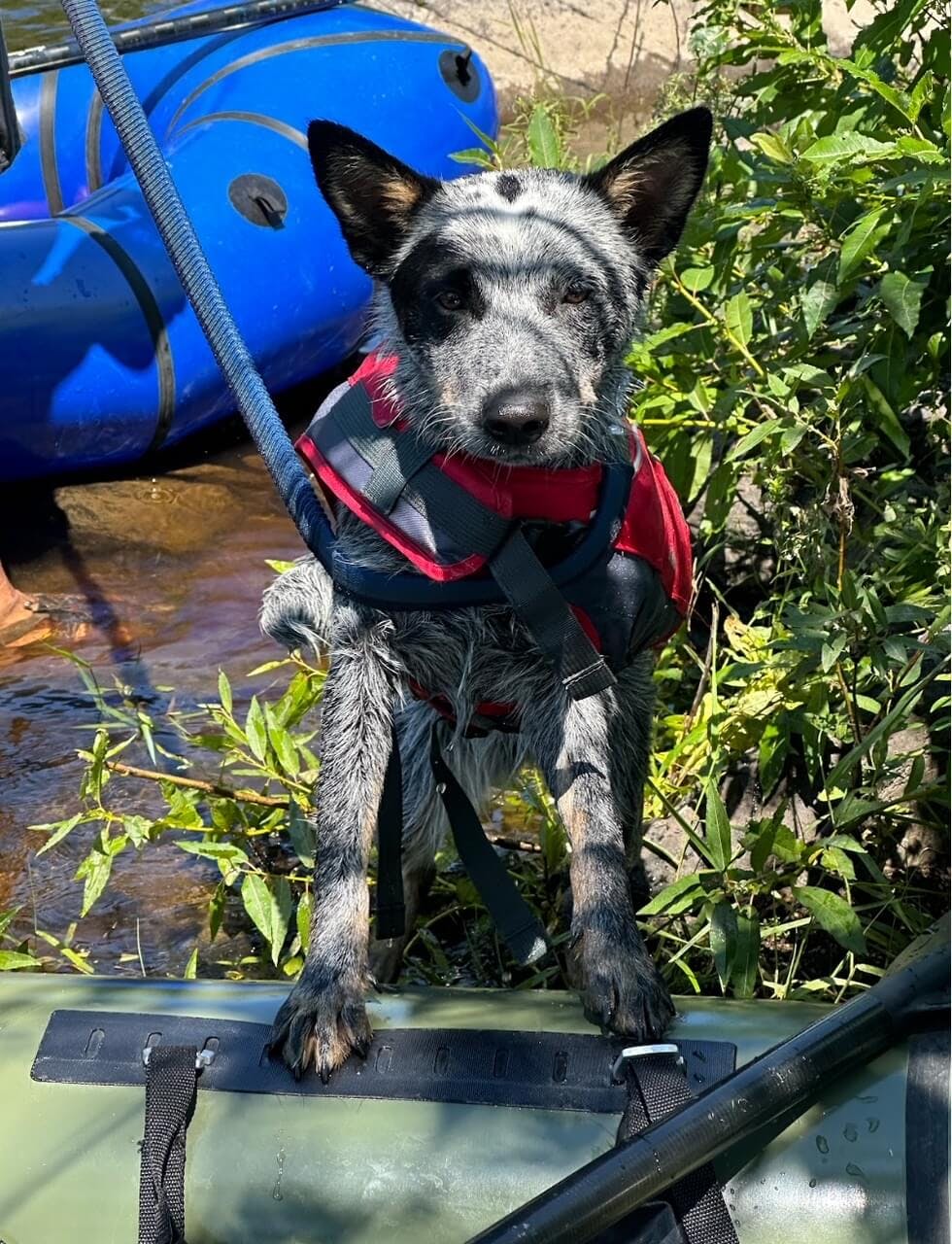
Hammy visiting other boaters, she enjoys switching boat partners.
Safety Gear Essentials for Your Dog
Canine life jacket with:
- Belly panels (not just straps)
- High-visibility colors
- Buoyancy under the chest and along the back
- A strong grab handle on top
Even strong canine swimmers benefit from a life jacket—especially in cold water or strong current. It helps your dog stay afloat if panicked, tired, or disoriented; and helps keep their head above the waterline to minimize the risk of water aspiration.
Critical Safety Note:
- Non locking carabiners can be dangerous on moving water, and pose a risk to you and your dog on flatwater as well. An accidental clipping of a leash or life jacket to the boat or debris in the water can occur.
- Never tether your dog to the boat. In swift water, leashes (especially those with hand loops or knots) become entanglement hazards that can trap or drown a dog if caught. No leash, or a short buoyant line with no knots, is safest.
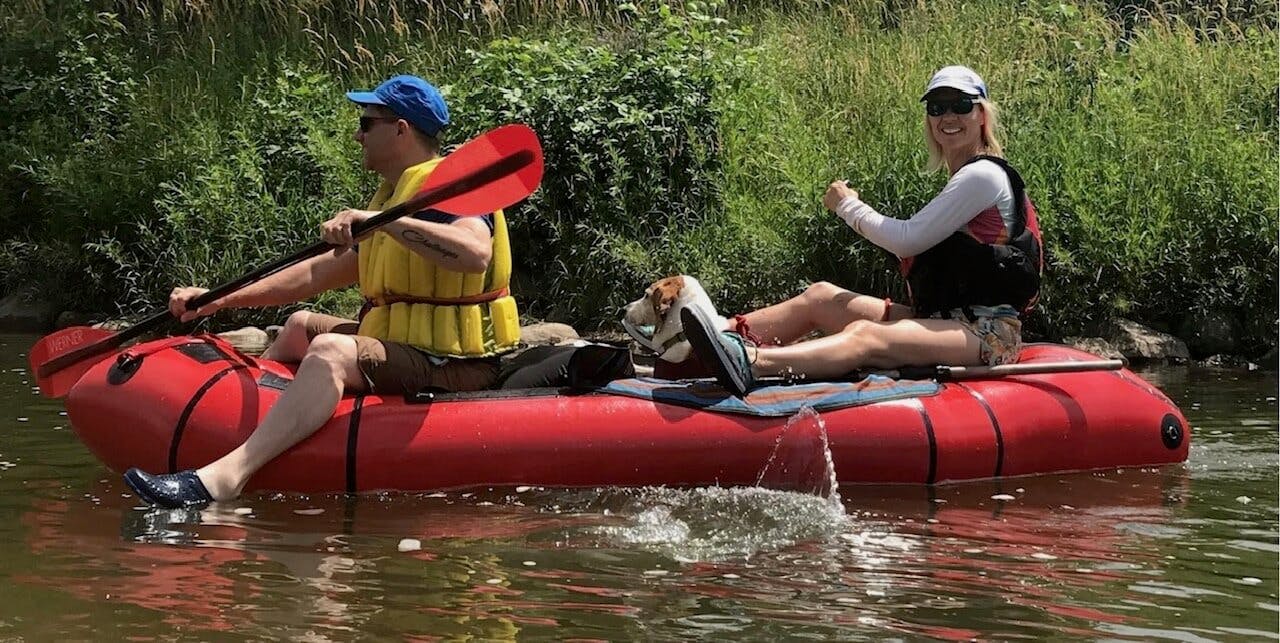
Photo: Krista Halling
Training: Build a Calm, Confident Co-Paddler
At a minimum, your dog should be able to:
- Settle quietly on command (e.g. “place” or “lie down”)
- Stay put in moving or unstable settings
- Be comfortable being lifted or handled unexpectedly
- Respond reliably to recall and to “leave it” and “wait”
Desensitization is key. Dogs need time to get used to the boat moving beneath them, the feel of the gear, and your paddle strokes. Practice in short bursts and reward calm behavior.
Bonus tip: Use a stable yoga mat, closed cell foam or rubber floor liner in the packraft to help your dog grip and feel secure. This reduces fidgeting and slippage, especially for senior dogs.
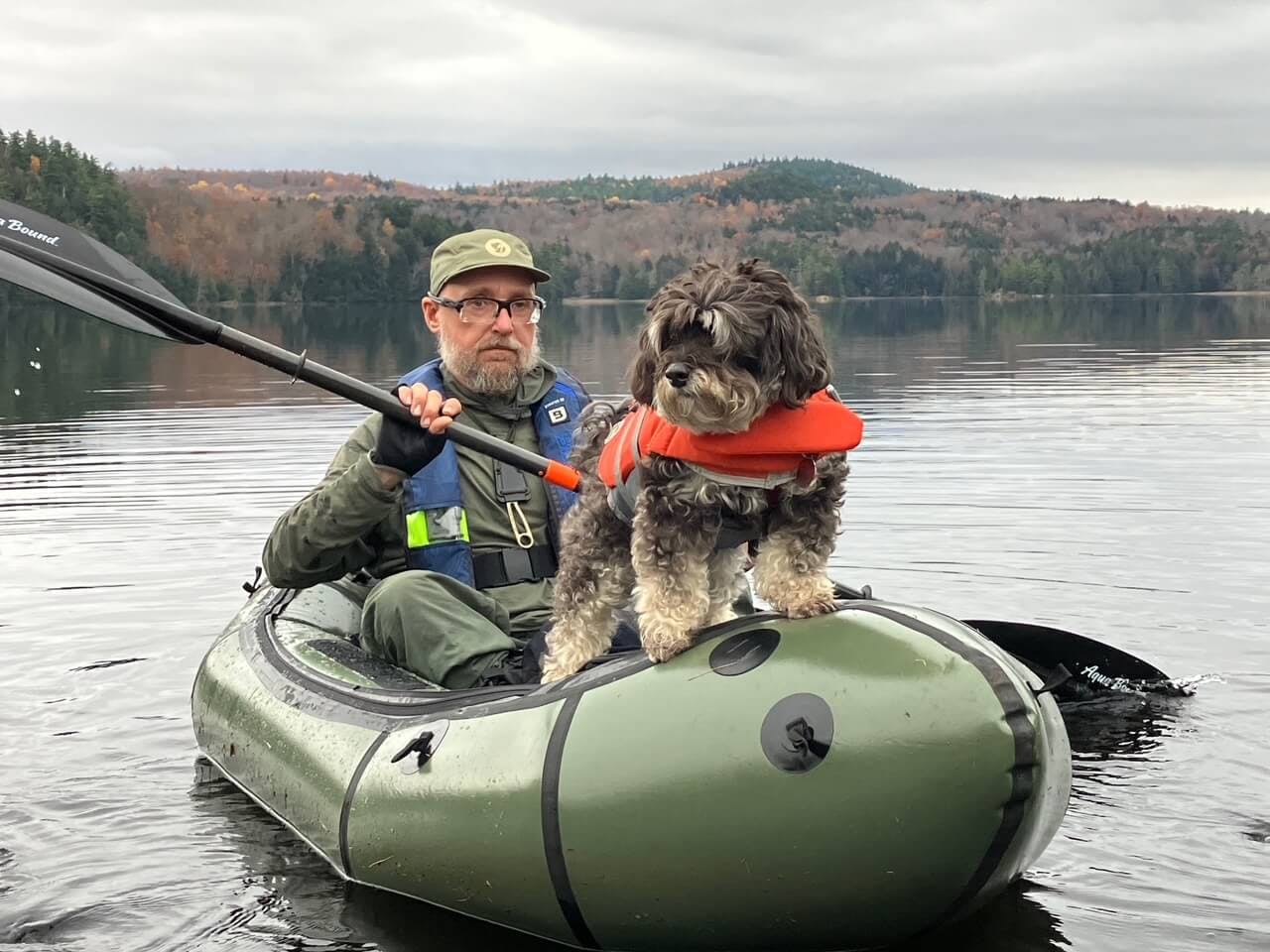
Elijah Kraatz and his dog Dusty. Photo: Elijah Kraatz
Trip Planning: Pick Safe Places First
Top picks
- Calm lakes or slow-moving rivers
- Beaches or shallow banks for entry/exit
- Short routes with turnaround options
Avoid
- Rivers with strong current, cold water, or upstream dams
- High-traffic boating areas
- Steep put-ins, rocky exits, or narrow landing spots
Apps like Gaia GPS or RiverApp can help you check flow rates and water levels. Some areas have seasonal hazards—like spring melt in northern regions or algae blooms in hot lakes—so do your research.
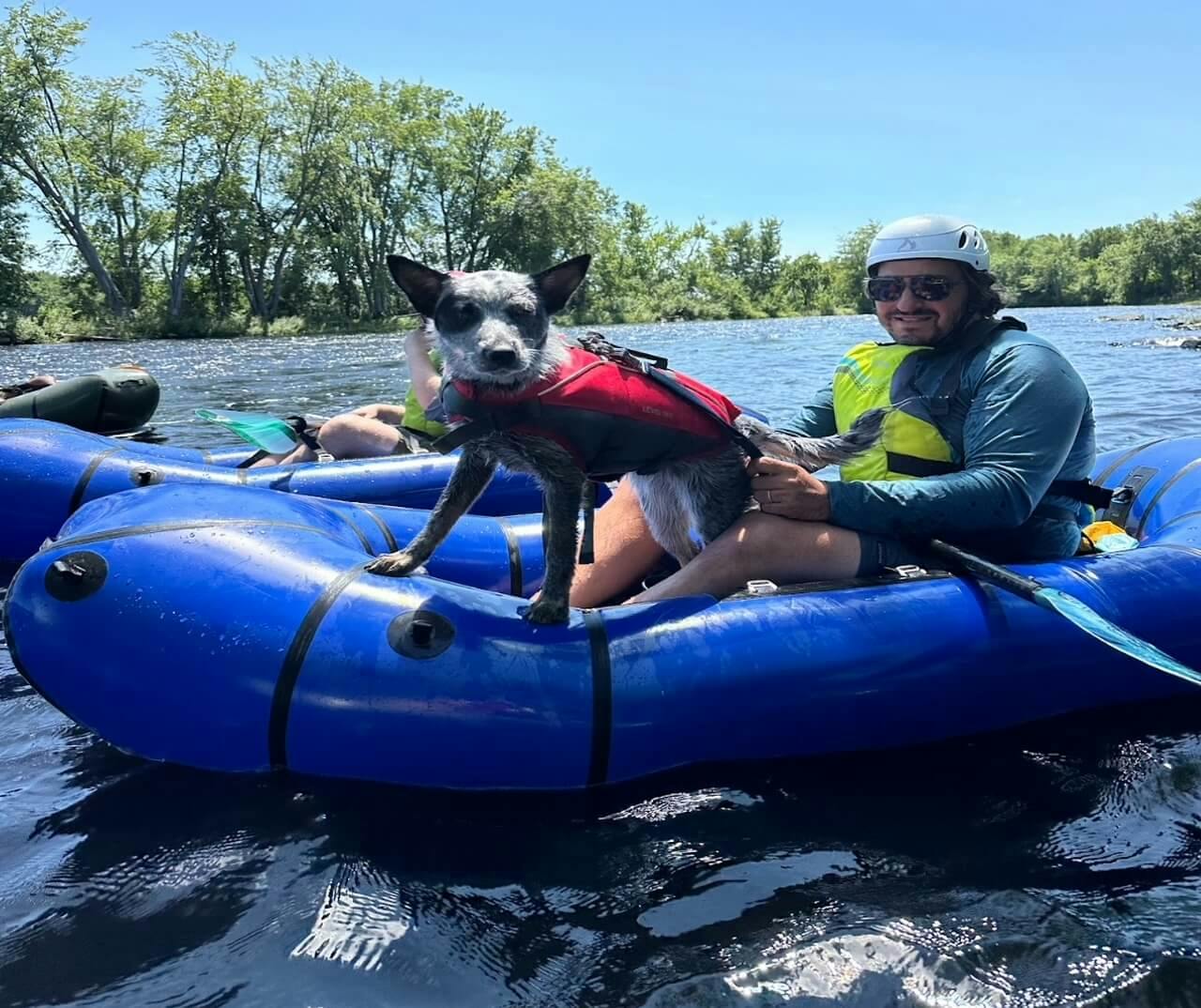
Hammy and his pet parent Alejandro enjoying checking in with everyone in the eddy.
Getting Your Dog Comfortable: Dry Land to Water
Step 1: Introduce the Packraft at Home
Let your dog sniff, inspect, and walk around the deflated packraft
- Place their bed or favorite mat inside
- Feed meals or treats in the packraft
- Gently rock it side to side while rewarding calmness
This builds what behaviorists call positive conditioned associations—basically, helping your dog think “this packraft = good things.”
Step 2: Move to Shallow Water
Start with:
- Calm, sunny days
- Shallow lake edges or gentle riverbanks
- Your dog wearing their life jacket (every time)
Sit in the packraft and let your dog enter/exit at will. Bring high-value treats and keep sessions short and relaxed. If your dog jumps out, let them—but practice calm re-entry.
At this point, your goal is building trust, not enforcing obedience.
On the Water: Shared Paddling Tips
- Paddle with slow, predictable strokes at first
- Avoid sudden turns or splashing (until your dog gets used to them)
- Keep your voice calm—dogs take their emotional cues from you
- Make eye contact and smile often (yes, really—dogs read faces better than we think)
Dogs that get restless often just need a break. Stop on shore, stretch, explore, and resume when your dog’s relaxed again.
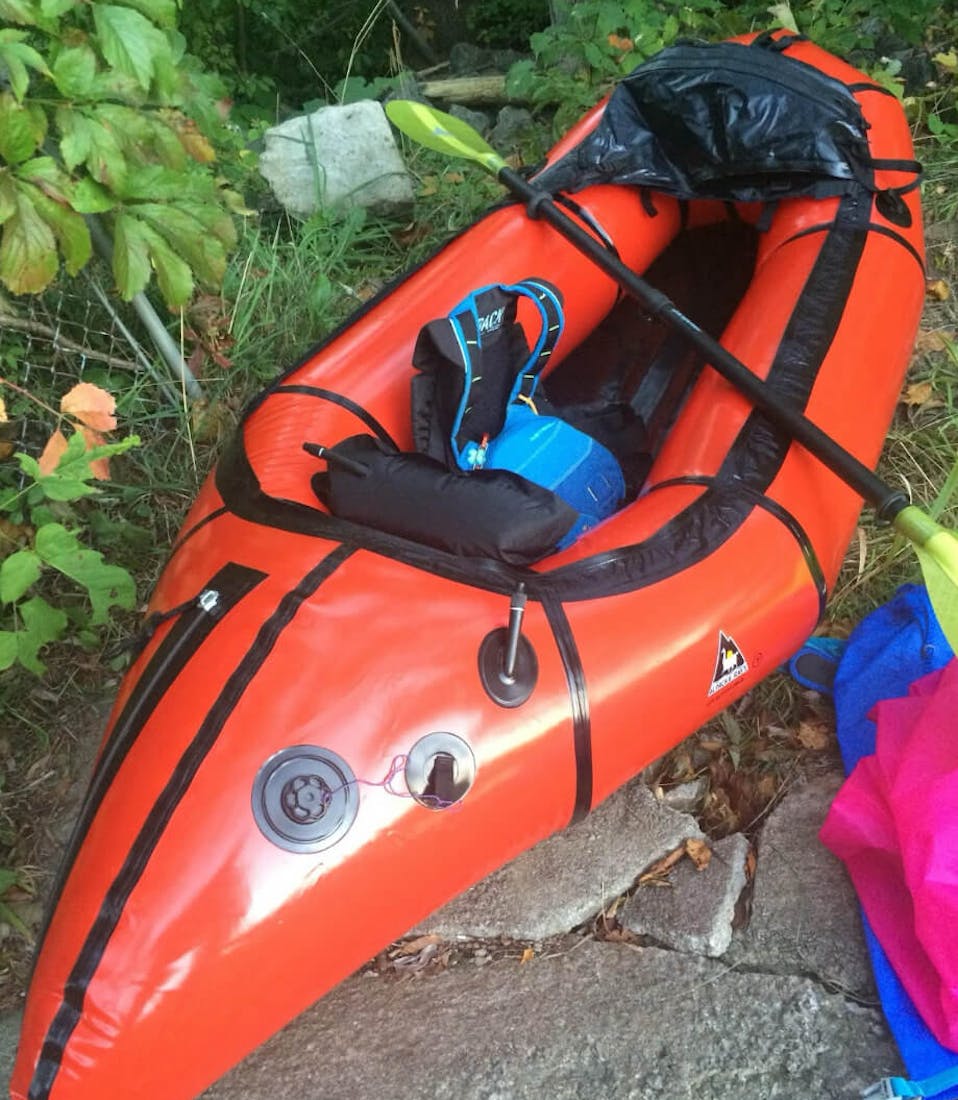
Packrafting gear, including a dog PFD in packraft. Photo: Krista Halling
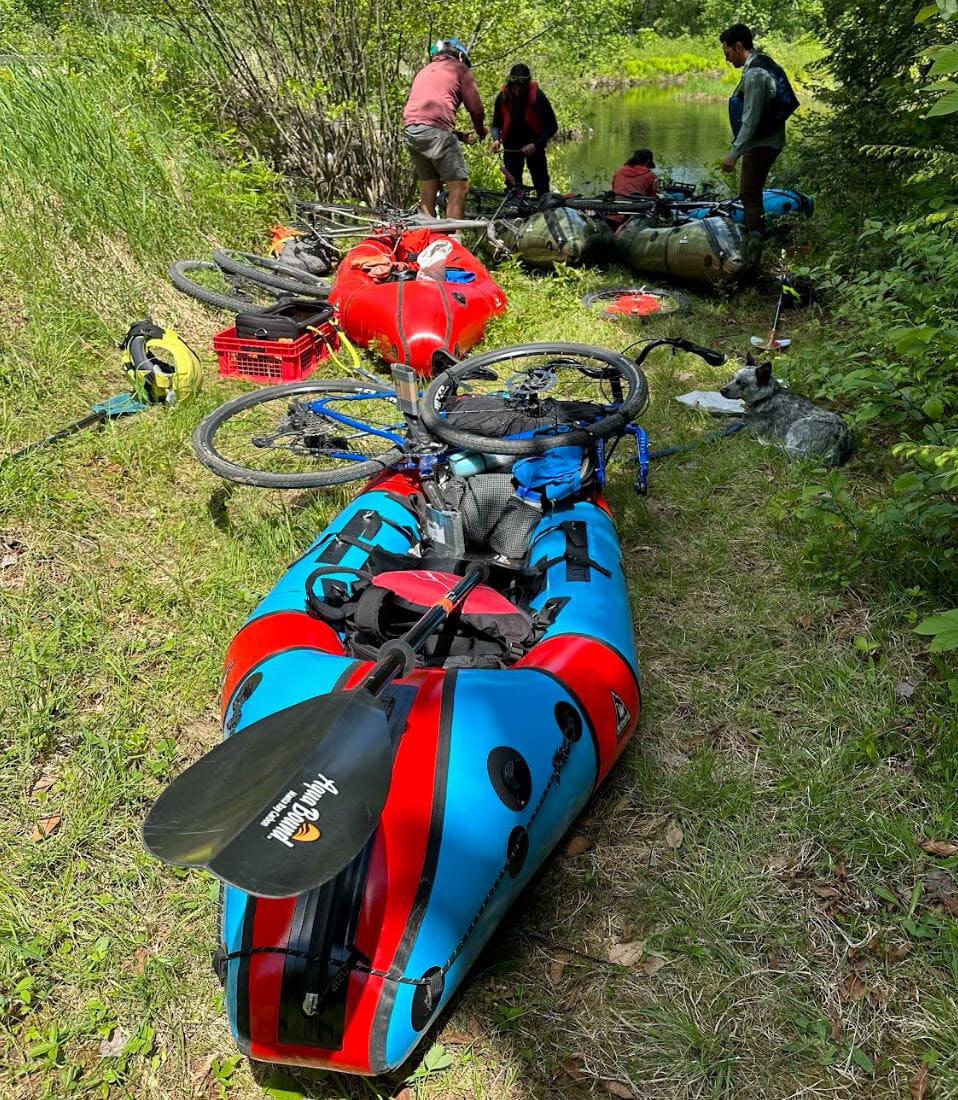
Hammy waiting for everyone to get there boats loaded so she can go paddling.
Best Practices for Swiftwater Safety with Dogs
- Know the river class. Never bring a dog into water that’s Class III or greater. The consequences of a capsize or a swim are potentially life-threatening.
- Always scout. Walk rapids before running them, and know all eddies and exits.
- Wear proper gear. Your dog should have a snug-fitting life jacket with a reinforced grab handle and belly panels.
- Train wet exits. Your dog should know how to swim to shore on cue and be comfortable being lifted or grabbed in water.
- Carry a throw bag. Not just for humans. If your dog gets swept downstream, you’ll need a way to direct or help retrieve them.
Know Your Class Ratings
- Class I: Moving current with waves and and easily avoidable obstacles – good for beginners
- Class II: Small and mid sized waves and avoidable obstacles – okay for skilled dogs and handlers
- Class III+: Technical maneuvers, big water – not recommended with dogs
Flatwater spills are usually benign. But in moving water, a flipped boat or a dog overboard situation can escalate fast. Add in:
- Cold water temperatures
- Strainers (trees or debris that trap objects)
- Undercuts, Sieves and hydraulics
- Long Swims
- Confused or panicked dogs
…and you’ve got a scenario where seconds matter.
Important: No dog should be paddling whitewater unless the human has taken a swiftwater rescue course and practiced wet exits and reentry—solo. This should be a foundational prerequisite.
Signs of Canine Distress in Current
- Paddling hard but making no headway
- Tucking tail or spinning in circles
- Head low in the water
- Refusing re-entry or panicking in the boat afterward
A dog that experiences a near-drowning or panic event may develop long-term aversions. Introduce current gradually and only after full confidence on flatwater.
If You Flip or Your Dog Falls In
- Stay calm – Dogs often find shore on their own
- Use the jacket handle – Don’t grab their limbs or collar
- Don’t jump in unless you’re certain you’re not putting yourself at risk
Train your dog to swim to you or the boat on command. Practice this on calm water. It can be a lifesaving cue in moving current.
Cold Water Warning
Even in summer, mountain rivers can stay dangerously cold. Dogs can experience:
- Hypothermia
- Cold water shock
- Reduced swimming ability due to stiff muscles
Dogs lose body heat 2–3x faster in cold water due to their higher surface area to volume ratio compared to humans (Martinez et al., 2018, J. Therm Biol).
Always dry your dog off after immersion and limit time in cold water.
Alejandro shares a story from his time training his dog Hammy to packraft.
He stressed the importance of identifying how your dog learns, and has fun. He has had dogs that need a lot of easing into new activities, and others that get quickly bored if you keep the activity too small.
Hammy struggled with the first parts of training while loving the activity as a whole: When Hammy and I first started working boat time, I was worried she didn’t like it because of how she reacted to putting on her life jacket and her not being interested in the boat on land. At a different occasion, when trying to get Hammy to wear a harness, I came to realize Hammy really does not like to wear them, yet she loves the activities she does while wearing them. We are working on making the putting on less of an issue, but it is wild how 30 seconds later she is in the boat and ready to go. With the boat on land it just didn’t capture her attention. Wherever we did it, she was noticing many more exciting distractions. What looked like not wanting to be in the boat, was just being excited by what was around her.
Once we got to some calm water, quickly put on her life jacket and transitioned to some fetch along shore she was ready to go. Once I placed her in the boat, she realized that this was a fun way to spend time together. For the first bit she stayed close to my legs, but slowly began to explore closer to the edge. Even going a little too far and falling in. Once I quickly pulled her back in by the handle of her life jacket, she restarted her exploration with a bit more respect for the edge, but still not fear.
By not getting stuck on the training of wearing the harness or staying in the boat on dry land we were able to move forward to a part she enjoyed. I was only comfortable pushing forward because of what I knew about her from her general training and watching her explore new experiences, she is easily distracted from easy tasks, engages better when being challenged, and rarely reacts with fear.
I am starting to train Midge our new puppy for trips, and it is fun to see the differences in their personalities come out in the learning process. She hasn’t been on the water yet, but her first short bike rides were a success.
Heat Stress Warning
Remember that life jackets are inherently very insulating and dogs can overheat in them. Always monitor your dog for signs of overheating and if any develop, immediately remove their life jacket and safely immerse your dog in cool water.
Leashes and Tethers:
Golden Rule: Never tether your dog inside the boat.
In moving water, a leash inside the boat becomes a noose. Dogs can be dragged, tangled, or trapped underwater. We never recommend leashes or teathers with dogs while paddling
Final Thoughts: Go Slow, Stay Safe, Make it Fun!
Packrafting with your dog can change how you see the world—and deepen your bond in ways few other activities can. Start on land, build trust, and let your dog guide the pace. You’ll gain a paddling partner who learns to love the water almost as much as you do.
About the Authors
Alejandro Strong is founder of Packraft Maine, a guided adventure company. Krista Halling is a veterinarian and founder of Dogpacking.com, an online resource with science-backed tips and inspiration to safely adventure with your dog.

